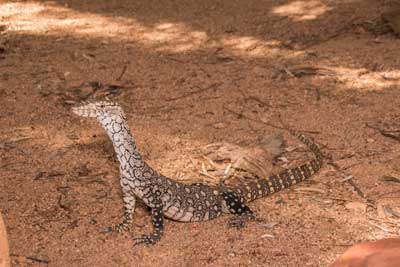
The Perentie (Varanus giganteus) is Australia’s largest lizard.
Adaptations
Goannas differ from all other lizards in having a forked tongue like a snake which they constantly flick in and out.
It picks up scents from the air and transfers them to a structure called the jacobsons organ, on the roof of the mouth, where they are interpreted. They are ectothermic which means they raise their temperature by basking in the sun.
Habitat
Goannas differ from all other lizards in having a forked tongue like a snake which they constantly flick in and out.
It picks up scents from the air and transfers them to a structure called the jacobsons organ, on the roof of the mouth, where they are interpreted. They are ectothermic which means they raise their temperature by basking in the sun.
Wild status
Common.
Diet
Perenties eat almost anything they can overpower including other reptiles, birds, mammals and carrion. They are significant predators to the introduced rabbit and house mouse. Their teeth are thin, sharp and backward curving like snakes.
They are designed for holding prey not chewing. Mouthfuls are swallowed whole, with a characteristic jerking motion, literally thrown down the throat.
Predators
Perenties are a delicious source of food for desert Aboriginal people and wedge-tailed eagles. Young perenties are vulnerable to snakes and other large goannas.
Size
The perentie is Australia’s largest lizards, growing up to 2.5m.
Extra fun facts
When threatened, perenties raise their bodies, distend their throats with air, and exhale noisily making a loud hissing sound. They can also cause injury to the intruder by whipping it with their very strong tail, and by biting or scratching with their large teeth and claws.
Goannas are among the world’s oldest lizard families and are thought to be highly intelligent.